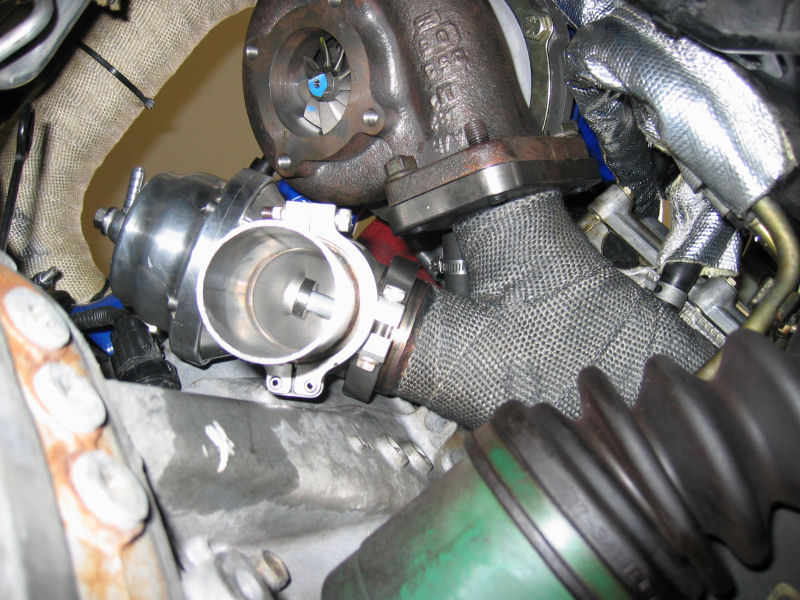|
Screamer Pipe
{{unreferenced, date=November 2018 A screamer pipe is a type of exhaust configuration fitted to some automotive turbocharged petrol engines with an external wastegate set-up, which vents the waste exhaust to the atmosphere through a separate un-muffled pipe, rather than back into the main exhaust track. This exhaust setup is known for its loud noise. Principle of operation To regulate the boost pressure on turbocharged engines a wastegate is fitted to allow exhaust gases to bypass the turbine and flow straight down the exhaust down-pipe. This can cause turbulent airflow around the turbine and high exhaust back pressure. To overcome this problem, gases can be re-routed down a separate pipe and vented straight to the atmosphere, resulting in improved performance. Limitations This configuration allows exhaust gases to flow straight to the atmosphere, therefore they do not pass through the catalytic converter or exhaust silencer A muffler (North American and Australian Engl ... [...More Info...] [...Related Items...] OR: [Wikipedia] [Google] [Baidu] |
Turbocharged
In an internal combustion engine, a turbocharger (often called a turbo) is a forced induction device that is powered by the flow of exhaust gases. It uses this energy to compress the intake gas, forcing more air into the engine in order to produce more power for a given engine displacement, displacement. The current categorisation is that a turbocharger is powered by the kinetic energy of the exhaust gasses, whereas a supercharger is mechanically powered (usually by a belt from the engine's crankshaft). However, up until the mid-20th century, a turbocharger was called a "turbosupercharger" and was considered a type of supercharger. History Prior to the invention of the turbocharger, forced induction was only possible using mechanically-powered superchargers. Use of superchargers began in 1878, when sev ...[...More Info...] [...Related Items...] OR: [Wikipedia] [Google] [Baidu] |
Wastegate
A wastegate is a valve that controls the flow of exhaust gases to the turbine wheel in a turbocharged engine system.Robson, D. (2018). Aircraft General Knowledge. Aviation Theory Centre Pty Ltd. . Diversion of exhaust gases regulates the turbine speed, which in turn regulates the rotating speed of the compressor. The primary function of the wastegate is to regulate the maximum boost pressure in turbocharger systems, to protect the engine and the turbocharger. One advantage of installing a remote mount wastegate to a free-float (or non-WG) turbo includes allowance for a smaller A/R turbine housing, resulting in less lag time before the turbo begins to spool and create boost. Wastegate types External An external wastegate is a separate self-contained mechanism typically used with turbochargers that do not have internal wastegates. An external wastegate requires a specially constructed turbo manifold with a dedicated runner going to the wastegate. The external wastegate may be pa ... [...More Info...] [...Related Items...] OR: [Wikipedia] [Google] [Baidu] |
Catalytic Converter
A catalytic converter is an exhaust emission control device that converts toxic gases and pollutants in exhaust gas from an internal combustion engine into less-toxic pollutants by catalyzing a redox reaction. Catalytic converters are usually used with internal combustion engines fueled by gasoline or diesel, including lean-burn engines, and sometimes on kerosene heaters and stoves. The first widespread introduction of catalytic converters was in the United States automobile market. To comply with the U.S. Environmental Protection Agency's stricter regulation of exhaust emissions, most gasoline-powered vehicles starting with the 1975 model year are equipped with catalytic converters. These "two-way" converters combine oxygen with carbon monoxide (CO) and unburned hydrocarbons (HC) to produce carbon dioxide (CO2) and water (H2O). Although two-way converters on gasoline engines were rendered obsolete in 1981 by "three-way" converters that also reduce oxides of nitrogen (); they ... [...More Info...] [...Related Items...] OR: [Wikipedia] [Google] [Baidu] |
Exhaust Silencer
A muffler (North American and Australian English) or silencer (British English) is a device for reducing the noise emitted by the exhaust of an internal combustion engine—especially a noise-deadening device forming part of the exhaust system of an automobile. Description Mufflers are installed within the exhaust system of most internal combustion engines. The muffler is engineered as an acoustic device to reduce the loudness of the sound pressure created by the engine by acoustic quieting. The noise of the burning-hot exhaust gas exiting the engine at high speed is abated by a series of passages and chambers lined with roving fiberglass insulation and/or resonating chambers harmonically tuned to cause destructive interference, wherein opposite sound waves cancel each other out. An unavoidable side effect of this noise reduction is the restriction of the exhaust gas flow, which creates back pressure, which can decrease engine efficiency. This is because the engine exha ... [...More Info...] [...Related Items...] OR: [Wikipedia] [Google] [Baidu] |



